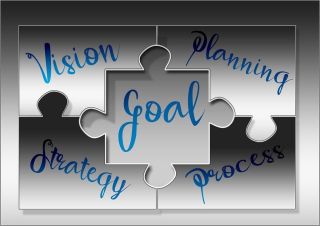Leadership
Planning and Organization vs. the Loftier Leadership Skills
To lead you have to plan and organize.
Posted April 21, 2024 Reviewed by Hara Estroff Marano
Key points
- Planning and organization are crucial to effective leadership; don’t leave it all to others
- Your vision for yourself and your organization may change, requiring you to change plans quickly.
- Learning how to leverage resources is a key component of effective leadership.
- The best leaders know how to accommodate others while still retaining control of essential functions.

When people think of what it takes to become a leader, they initially cite vision (an ability to imagine the future) and determination (the will to get there). I make a living, in part, coaching people in both these areas. But so much of leadership requires more mundane attributes—for example, planning and organization, which largely involve logistics.
Logistics? Isn’t that for middle managers?
No, it’s complementary to nominally loftier leadership skills that first come to mind. It extends these skills into day-to-day particulars that delight MBAs but drive the poets crazy. The lofty segues into the mundane.
So, if we like to think grand thoughts, how do we develop an interest in the nitty-gritty? How (conversely) do we conceptualize the big picture? Can we know what’s coming next and when to emphasize what? Planning and organization are as much a source of anxiety as pursuing a vision and determination are—in fact, just down-to-earth versions of that pursuit. Moreover, as in every stage of everyday leadership, we will have to deal with issues of compromise. How can we invite others to make substantive contributions while still not surrendering our initial vision? This becomes a particular challenge as our enterprise grows and matures.
Even though a leader may possess a motivating vision and pursue it with determination, if he or she fails at planning and organization the whole project could fall apart. So, it is important to understand what “planning” and “organization” require.
When we plan, we look ahead to specific steps that we’ll need to take in order to make progress. Organization, however, is less forward-looking than it is concerned with now: How do I execute the plans that I have put in place—i.e., how do I translate my overall design into the day-to-day nitty-gritty demands of a project that’s subject to real people’s whims and to contingencies that can gum up the works?
Planning and organization are thus two sides of the same coin: You can’t have one without the other, and neither one is sufficient on its own. You must specify how you want to get from A to B to . . . wherever you want to end up, and then follow through by taking real-time, effective actions.
So, planning-and-organization, as an inseparable duo, raises a series of questions to consider as you embark on a leadership project. As I suggested, this double-edged concept largely concerns logistics. Thus, if we like to think grand thoughts, how do we develop competence in the nitty-gritty? How (conversely) do we keep the big picture in focus when we are mired in the quotidian? How can we know when to emphasize what? How do we determine the right way to follow through when our plans may be subject to change? Planning and organization, as much a source of anxiety as pursuing a vision, are just rubber-meets-the-road versions of that pursuit. Moreover, as in every stage of everyday leadership, we must deal with sometimes conflicting demands from our team, from multiples constituencies, even from banks. How can we rely on others to share the work without surrendering at least some of our initial vision? Will our determination falter if our vision is compromised, or if we’re mired in keeping it intact? These questions become particularly challenging as our enterprise grows (and there is simply more to do).
When I work with clients, we examine organization and planning holistically—both are always in play—even while one, at times, may take precedence over the other. In one case, for example, a woman faced the challenge of leading a project that, for her, was a leap into the unknown. How could she make plans when she’s just getting to know the terrain, when her experience may provide some but not the definitive guide? She learned as she went along, never getting too far ahead of herself and adjusting her plans to address inevitable contingencies.
Another client, a mature business leader, faced the dilemmas entailed in long-term planning. How could he even make plans when the situation was fluid, unpredictable . . . and subject to a potential cash crunch? He learned how to bring in others for support at crucial junctures. In other words, he organized on an ad-hoc basis: His skill was in spotting what he needed as the need arose.
Still another client, a young doctor, sought to lead a project guiding a new drug through the thicket of FDA rules for its approval. He asked me, “How am I a ‘leader’ when the government prescribes what I do at every turn?” He learns that creativity is called for even in an administrative role and that successful administration is a necessary form of leadership. He organized a massive project, leveraging one resource to gain access to the next. Knowing how access resources—and make the most of them —is crucial to any leadership project.
So, as you think about your own logistical challenges, consider some of these concerns:
- Planning and organization are inseparable; you should have big-picture skills even while exercising judgment concerning day-to-day, operational details.
- Just as a vision is subject to change, plans can change as a project develops, so, be ready for contingencies with plans that are flexible.
- Never dismiss the need for effective follow-through (“I’ll just leave the boring stuff to other people”) since, without its adequate execution, your whole project can fall behind schedule and even fail.
- Learn how to locate and make optimal use of resources and how to leverage one resource to access the next.
- If you treat people as “resources,” never forget to also treat them as people; people are not fungible and have their own specific needs
- You can put your stamp on a project as its leader, even if your leadership is mostly administrative; good administration can be creative.
You can apply these principles to your own situation. You can learn as you proceed and remain flexible. Plans are not straitjackets. Your organization can change as your plans develop, and as new needs arise. The point is to stay focused so that you can respond in real time with your utmost energy and creativity. Commitment, while crucial, does not mean that you should feel tied down to a particular way of doing anything. To be creative is to be nimble.


